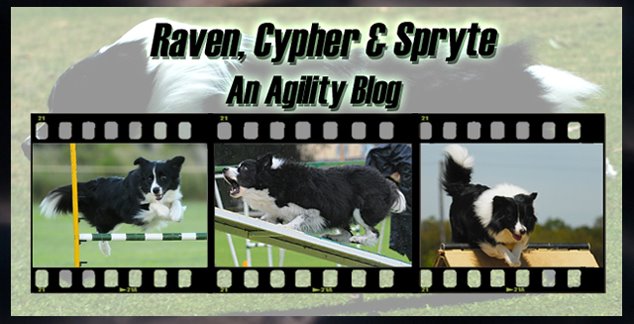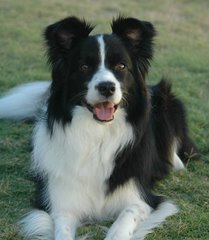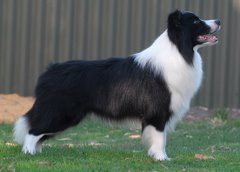TNS Research Update Report
21 May 2007
The donations in 2006 to TNS research from the Border Collie Clubs of NSW, Vic and Qld and several generous breeders from Australia and US came at a critical time and has allowed us to continue the work which has identified the TNS gene and found what appears to be the mutation responsible for the disease. This work was not possible without the samples from litters with affected pups that were provided by breeders. The enthusiastic work of breeders to spread the word about the problem and the research has led to the attraction of funds from the UK Pastoral Breed Health Foundation which had set aside funds to support genetic research in working dogs. Together these funds have allowed us to make rapid progress toward our main aim, which was to identify the TNS mutation, and to examine its distribution in Border Collies around the world.The funding has provided the consumables we need to do the lab work and the PBHF funds provide a PhD Scholarship for Jeremy Shearman, which now allows him to work full time on the project. The support has allowed him to examine nearly all of the TNS gene in 2 TNS affected dogs and 2 carriers and several controls in just 6 months. He has tested about 30,000 DNA bases that make up the functional part of the TNS gene and has found what appears to be the mutation that causes the disease. We need to confirm this by showing that the mutation exists in the large number of affecteds and carriers that we have already tested, and not in unrelated unaffected dogs. To do this we need to develop acost effective, efficient test for the mutation. Once we have shown that this DNA difference is the cause of TNS in all known carriers, we will check that all of the dogs predicted to carry the mutated TNS gene by our previous test examining segregation of chromosomes in TNS related animals is 100% accurate.
We will also screen samples that showed no sign of TNS to confirm that no other chromosome types also carry the TNS mutation.The identification of what is very likely the TNS mutation means that we can now test any dog for TNS. Dogs to be tested no longer have to be related to knownTNS carriers. Information on samples submitted for testing and test results are kept confidential by us and owners are encouraged to publish their resultson the Border Collie Health web site. This means that not all of the test results are generally available yet.This good news of identifying the TNS mutation is well timed as it balances the bad news that the application for funding of this research through an ARCLinkage Grant was not successful.
We will continue to rely on donations and funds raised from our DNA testing to fund further research in Border Collies andother breeds.Since February, we have typed 800 samples to reveal 180 carriers and 2affecteds. Twenty-one of the carriers were from recent litters. We haveidentified 7 carriers from English ISDS lines to date. This supports theunconfirmed TNS cases from ISDS lines on the Border Collie Health Website astrue TNS. It also indicates the mutation is very old and has been around in thebreed for a very long time.Testing has been difficult on a small proportion of samples. This has led to asmall number of revisions of preliminary test results. Some buccal swabs do notprovide enough DNA for testing and so blood samples are preferred. Poor qualityof sample leads to delays in results and are much more likely to produce errors.It is hoped that the new test being developed will allow testing of even thepoor samples that have been submitted.Any samples will now be accepted for TNS testing at UNSW. Forms are availableon the Border Collie Health website, htttp://bordercolliehealth.com , on theTNS page. Once samples arrive in the lab it takes two to three weeks to enterdetails into the database, run tests, and send out results by email, so plantesting accordingly. The preferred sample locally is blood in EDTA tubes whichmust be packaged properly to send in the mail. Blood on FTA cards is moreconvenient for international samples. Mouth swabs can be sent from puppies atjust a few days old but a proportion (~10%) of swabs do not work so resultscannot be guaranteed and duplicate swabs are recommended.
DNA testing of genetic diseases such as TNS, allows breeders to continue to usecarrier animals in matings (if mated to TNS clear animals) and test the progenyfor carrier status. This means no desired breeding lines need be lost andbreeders can still select the best puppies to keep for breeding without anyfurther risk of producing TNS affected animals. Over a period of severalgenerations the disease can be eliminated from the breed by testing and selectedbreeding. Then testing will be no longer necessary. TNS is inherited as arecessive disorder like CL and CEA. If both parents are tested clear of TNSthen their progeny must be also free of the TNS mutation. In matings where oneparent is a TNS carrier, about half of the pups, on average, can be expected tobe carriers. In some litters all pups will be carriers and in others none willbe, but each pup has a 50:50 chance of being a carrier if one parent is. Foreach puppy from matings between two carriers, there is a 1 in 4 chance it willbe affected, a 1 in 4 chance it will be clear of TNS, and a 1 in 2 chance itwill be a carrier. But such matings can result in any combination of affected,carrier and normal pups. For example, one litter had 4 affected, 3 carriers and1 clear puppy.
TNS has most likely been in the Border Collie breed since it originated as itoccurs in several lines that are only distantly related. It occurs in show dogsoriginating from Australia/New Zealand, in pure English working dogs and inAustralian working dogs that are unrelated to the show dogs. The disease canpresent as very different symptoms from one affected litter to another which hasmade it difficult to recognise as a genetic problem. It is probably the majorcause of "fading" or "failing" puppies. Now a DNA test exists there shouldnever be another puppy affected by TNS and eventually TNS can be eliminatedfrom the breed. The purpose of this research, undertaken at University of NewSouth Wales in Sydney, has been to assist breeders improve the health andwelfare of the dogs. A side benefit is that the research could also assist inthe knowledge and treatment of the disease in human patients.Testing is currently only available at UNSW where the TNS and CL tests have beendeveloped. The research into developing a more widely available TNS test anddetermining the prevalence of TNS in the breeding population continues to bedone by PhD student, Jeremy Shearman. Without the support of the breeders andowners, the amazing progress Jeremy has made in a short time would not have beenpossible and his work could not continue.
Alan Wilton,
PhDSenior Lecturer in Genetics
Head of Canine Research Lab
Thursday, May 24, 2007
Great NEWS for Border Collie Owners/Breeders
Posted by
Simone
at
8:03 AM
![]()
Labels: border collies, genetic testing, health, TNS
Subscribe to:
Post Comments (Atom)




No comments:
Post a Comment